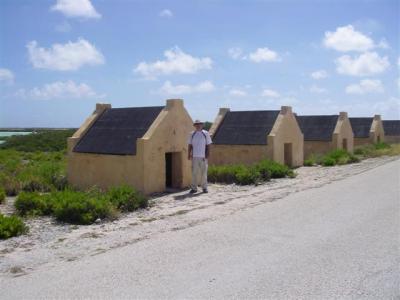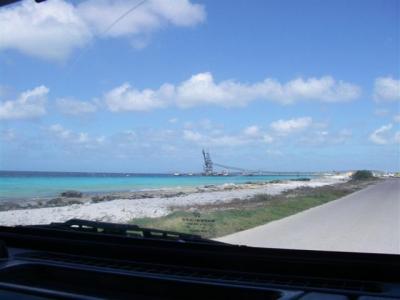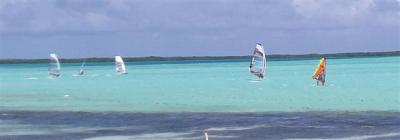Continued from yesterday”¦ Near where the wetlands turned into Luc Bay, the salt pans started. Almost all of the south side of the island is owned by the salt company, and there are miles upon miles of salt drying “pans”, which are large, shallow troughs of water dug into the ground. As we drove south, we found ourselves on a narrow strip of land. To our left was the ocean and to our right were the pans.
There were quite a few flamingos grazing in the salt pans, all out in the distance, of course. The flamingos feed on brine shrimp, crustaceans, plankton and algae, which are all easily accessible in the shallow pools. We know that deeper in the salt flats is a flamingo sanctuary, one of the four main breeding sites for the entire Caribbean flamingo population. There is no road to get there, it is strictly off limits to the public, and it is too far from the road for people to see them. It sounds like the flamingos here regularly fly back and forth from Venezuela.
On the windward side of the ocean there were huge waves pounding the shore. We passed a lighthouse at the southernmost point of the island. As we came around the bottom of the island towards the leeward side, we saw the infamous slave huts. They are situated just at the edge of where the surf dies down, close to the lighthouse. Beyond the huts, on the ocean, there were some kite boarders skimming along the water, just like the day we arrived on Kosmos. It is really quite scenic.
The huts are almost shocking. They were built in the 1850’s, and were apparently an upgrade from the mud huts that were used prior. Several people were crowded into these shelters. As you can see, they are tiny — barely long, wide and tall enough for someone short to stand up/lay down in. Putting two people in one of those would be “cozy”, particularly if one of them was tall, and apparently many people were crowded into each of them.

The salt mining work was hard — slaves used wheelbarrows, shovels and picks to mine the salt in the burning sun. Ships picking up the salt would anchor off the coast. The slaves would load basketfuls of salt into dinghies and deliver the salt to the ships.
As the road continued north, the salt pans changed in color from clear to purple. It is kind of surreal to see purple pools of salt, but cool looking none-the-less. We passed numerous trucks pulled over on the side of the road, clearly divers who are doing shore entries. We passed mountains of (white) salt piled up near an interesting looking, roller coasteresqe contraption that moves salt to a dock where ships can tie up. It amazes us that the mountains haven’t melted away in all the rain.


The mountains and contraption must mark the northern end of the salt mines because shortly beyond we started to see some residences and hotels, many looking to be brand new, and some under construction. One development has dug a man made canal, and the houses being built will all have private docks. We passed the airport, which is tiny. The airport is on the edge of downtown, and a few minutes later we were back in the heart of Kralendijk. Someone had mentioned that we might be able to find a camera in a store on the north side of town, so we drove over there. Of course, no luck. We went to a nearby restaurant for lunch.
After lunch, we headed back to Luc Bay. There were less windsurfers in water, but still a lot. We checked in at the shop and they took us down to the water where our beginner rig was awaiting us. The board is extra wide and extra stable, with a big rudder. The sail was quite colorful and small compared to the other rigs out on the water. In this photo you can see how much smaller the beginner rig is compared with the other three upright rigs in the water.

Our beginner package consisted of a one hour less and an additional hour of practice. The instructor walked us through all the basics while we were still on shore. He clearly does this many times a day and had his spiel completely memorized. “Bend your knees, lean over, grab the sail handle, straighten your back, slowly straighten your knees as you pull the sail up. Grab the steering handle with your forward hand, then hold loosely with your back hand. Turn the handle ever so slowly and gently to fill the sail with wind”¦” Picking up the sail takes a little strength, but it is actually not as much effort as we expected it to be, probably because it is a smaller sail. It all seemed pretty straightforward, and after a couple dry runs on the shore, we dragged our rigs out to the water to do it for real. The water near the shore was so shallow that there were a couple places where our extra long dagger boards got stuck in the sand.
The water everyone was sailing in is only knee deep. Eric hopped on the board and got the hang of it right away. He was able to balance himself, steer, and turn with little difficulty. At the end of the one hour lesson, he upgraded to a bigger sail that made him go faster. He found the bigger sail to be more sensitive, needing to be held totally perpendicular to the board in order to track straight. The slightest angle of the sail would have him veering off to the side.
Christi had a much harder time. No one has ever accused her of being graceful, and sports that require a sense of balance don’t come easily for her. Actually, sports period don’t come easily for her. It took her a long time to balance properly on the board. Once she was comfortable with the board, she kept getting too much wind in the sail and falling over. A couple times, the sail got stuck on the board and Christi had a hard time getting the two untangled.
When you get too much wind in the sail, you are supposed to let go of the steering handle with the back hand and continue to hold it with the front hand, which will make the sail move out of the line of the wind. Once she grasped the concept that letting go means you won’t fall over, she kept letting go with both hands — so busy being proud that she hadn’t fallen over that she didn’t notice she wasn’t moving anymore. Eventually, she got the hang of keeping the right amount of wind in the sail, and steering and turning came without too much more challenge.
We knew there is a nudist beach in the general area, but we didn’t know exactly where it is located. At one point, Christi finally had a good run going. She moved south beyond the surf shop. She was so proud of herself this was by far the farthest she had gone yet! She glanced over at the new scenery and saw a dock. She noticed an older man standing on the dock. Then she realized she couldn’t see a bathing suit. Is he naked? Oh, yes, he was naked all right! She was so caught up in gawking that she almost toppled over, but at the very last second regained composure over both herself and her rig. She turned around and sailed back towards the surf shop. We know where the nudist beach is now.
By the end of the one hour lesson, she finally had grasped all the basic skills, and continued her hour of practice with the little sail, putting along like a turtle. By the end of our time, the bay had emptied out and there was virtually nobody left at all in the water.
The entire time we were in the water, the wind had continued to pick up, and by the second hour it was screaming. The instructor said that today wasn’t the greatest day for learning because there was more wind chop in the bay than normal. As the wind increased, one had to move faster and more precisely to get up. If you were too slow, the wind pushed you over. If you had the sail poorly angled, you would blow over. We found sailboarding to be a lot of fun, but it was less fun in the heavier wind at the end than it was in the lighter wind at the beginning. The wind was blowing in some ominous looking clouds.
After the lesson was over, we went back to the boat and showered. We decided it had been too long and busy of a day to venture back out for dinner, so we had a quiet night aboard Kosmos. It started to rain around 2000, and it rained long and hard. That made us sad. It meant we’d probably be doing the short road tomorrow at Washington-Slagbaai.
